|
|
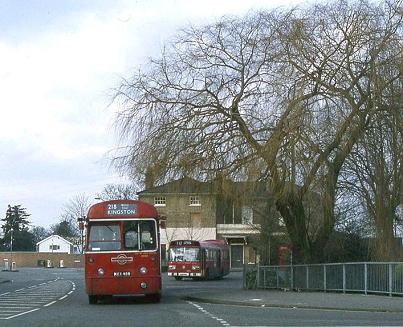 Red RF routes Red RF routes
Route 218
Page last updated 14 January 2020
RF512, which five
weeks later would be taking part in the famous tour, seen leaving
Staines West Station for Kingston on 24 February 1979. Behind
is one of the early LS-class Leyland Nationals working the 117 from
Hounslow, the garage which had received the entire first batch
two and a half years earlier. Later deliveries would oust the
last RFs. Photo © John Parkin
The last route to operate RFs in London. By a nice
coincidence, the 218 started life as the 62, the route number* that
was to host the last RTs a week after the
last RFs. The 218 was a relative latecomer to the RF
class, having to wait until Muswell Hill could double-deck the
212 in 1960. Dates of RF operation
6 Jan 60 to 30 Mar 79
Converted to OMO 7 Sep 68
(total 19 years 4 months, of which 8
years 8 months crew-operated)
Destinations
KINGSTON Bus Station and STAINES Moor
Lane via Walton-on-Thames
RF Garages
K Kingston
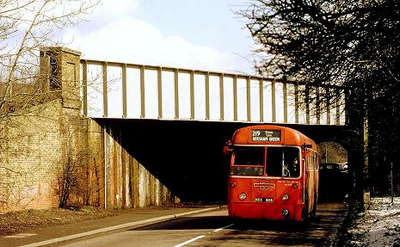 Reason for single-deck
operation Reason for single-deck
operation
As with many of Kingston's south-western routes, the 218
passed under the low bridge on the
Portsmouth Road at Ditton Marsh. This now has road markings
to indicate the safe area for high vehicles. Ian
Hogben recollects that these markings (and those on the
bridge) only appeared after the end of RF operation. In
addition, the 218 passed under low bridges at Hersham Road, Walton
and at Thames Street, Staines.
The main south-west railway line crosses the
Portsmouth Road at Ditton Marsh. No warning markings on 17
Mar 79; from the south, the narrowing that occurs part-way under
the bridge is not so evident, but the arch is visible in the
distance. RF507 (still with its grey relief two weeks before
the end) runs a 219 short to Hersham Green.
Photo © Richard Cripps
For most of his time on the 218/219s, he reports that 'it
wasn't uncommon for experienced drivers to enter the bridge from
opposite directions at the same time. If you had the bottle, there
was room for two RFs to pass, though the gap between the bus roof
and the underside of the bridge on the Esher/Staines bound service
could be measured in thickness of fag papers, rather than
inches.' He also remembers following a car approaching
the bridge (travelling towards Esher) and spotting a large Waste
Carrier coming the other way in the middle of the road, already
halfway through the bridge. 'Mister car driver decided the truck
was taking up more than his fair share of road and, standing up for
his rights, entered the tunnel, forcing the truck driver to pull to
the left (towards the pavement). The road was subsequently closed
for many hours and, in the end they had to let the air out of the
tyres of the truck to get it out. And that was only one of many,
hence the later need for clear markings.'
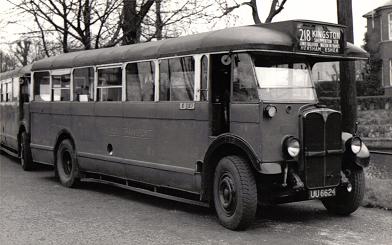 Route history
On 4 Jan 22, the General started operating route 62 between
Kingston and Shepperton Station, using two 26-seat B type
single-deckers from Kingston garage (K), which opened that
day. The Bs were replaced by new and larger Ss
later in the year. The following year, on 16 May, the route
was extended, over what must have been less promising territory,
via Laleham to Staines. Drivers were warned about the narrow
winding roads in Laleham and a hazardous cross-roads. In May
1923, Weybridge garage (WB) opened and joined Kingston in working
the route. In 1924, the 62 ran hourly.
1T1 T9 is seen at Staines
West. Photographer unknown
In common with other routes at the time, there were plans in
1925 to extend the 62 on Sundays to Burnham Beeches, via Datchet
and Slough. However, Slough Council refused permission and
the extension operated only (if at all, there is some doubt) at
Easter that year.
In the renumbering of October 1934,
the 62 became the 218. Three months later, route number 62
was reallocation to Barking garage for a new route to Little Heath,
and the rest, as they say, is history.*
The 218 was jointly worked, with Ts by K and WB, with route
217 (formerly the 61) which ran from
Kingston to Staines along the 218 to Walton, then via Weybridge and
Addlestone. This arrangement continued until October 1937,
when the 217 was replaced by an extension to Country Area route
461. But a pattern of joint operation of Kingston's routes
had been established. A few months later, the first LT
Scooters were allocated by Kingston on Saturdays, until about the
outbreak of war. At about the same time, WB closed and K
took sole operation with Ts.
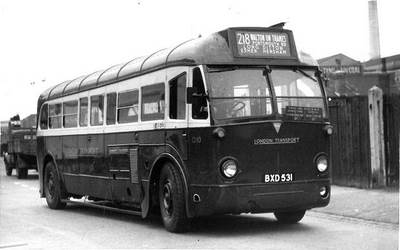 4Q4 Q10 is about to turn into Kingston Garage
to take up a short working to Walton-on-Thames, not crossing the
bridge, so not restricted to 1T1 operation. Note the 'minimum
fares' panel, deterring short riders by setting a minimum fare of
2½d on leaving Kingston. 4Q4 Q10 is about to turn into Kingston Garage
to take up a short working to Walton-on-Thames, not crossing the
bridge, so not restricted to 1T1 operation. Note the 'minimum
fares' panel, deterring short riders by setting a minimum fare of
2½d on leaving Kingston.
Photo © Alan Cross
Perhaps due to its proximity to the Brooklands aircraft
factories, Walton Bridge was damaged in an air raid in 1940, and as
a result a 7-ton weight limited was imposed. The only buses
that met this limit fully loaded were 1T1s, resulting in their use
for journeys west of Walton on this route. After the war,
when the fleet was in a poor state, this requirement led to the
rebuilding by Marshalls of Cambridge of 18 1T1s, alongside a larger
number of Scooters. The completed buses were returned in 1949
with the expectation of four years' use until the planned new
bridge would be open. These buses joined the remaining 7
unrefurbished 1T1s at Kingston in summer 1949, where they were
joined by one more rebuilt at Chiswick. The 1T1s had
been assisted by many of the ex-Tilling 3T3s, until the
last of that class expired in 1949, and some of the ex-Green Line
1/7T7/1s, which finished their lives here in May 1950,
petrol-engined to the end.
The peak allocation Monday to Friday had increased from 5 before
the war to 20 in 1950 as the route increased in importance; three
of these were for short workings that did not cross the
bridge. As a result of the Marshall rebuild programme,
sufficient buses were now available for the introduction of a
second route over the bridge, the 264.
However, not all of the 1T1s survived until the opening
in 1953 of the new bridge (which we are informed by Pablo
Haworth is a Callender-Hamilton bridge, not a Bailey bridge as
sometimes reported). Their replacements were 4Q4s and 14T12s
(which arrived new at Kingston in May 1946, the second garage to
receive them after Uxbridge for the 223)
- as well as use on the Kingston to Walton short workings,
these covered for 1T1s before the lifting of the weight
restriction, running over the bridge subject to a limit on
passenger numbers. (In
LHRG Bulletin 157, John Aldridge reports that when new, 14T12s
did use the bridge, recalling seeing them passing through Staines
in 1946 in place of the 1T1s and ex-Tilling Ts. He
recalls they suddenly disappeared, with the older buses returning -
perhaps it took a little while for Kingston garage to become aware
that the new buses were too heavy for Walton Bridge. He also
recalls 1/7T7/1s T244, T273, T369 and T391 on the route, all
buses with interesting histories.) The last 1T1s ran on the
218 on 31 Jan 53, the same day as the last Scooters at Dalston
and marked the end of London's oldest single-deckers.

From April 1942, the route was jointly worked with the
219 for 18 months, with this arrangement
reappearing on weekdays from April 1946 until October 1949,
when the 219's joint allocation moved to the 215. The 218 also periodically
received buses from the 215, until 27 Jun 51
when the whole Monday to
Friday allocation was inter-worked between the 215,
218 and 219 (however, the joint allocation of Qs and Ts was
misleading as the through 218 journeys could still only be
worked by the lighter Ts). In addition in this period, the
Sunday Kingston to Walton shorts were worked from the 215
allocation. In practice during the late 40s and early 50s,
when Kingston had allocations of LTLs, Qs, pre- and post-war Ts and
TDs, there was much interchange in the actual buses used on the
routes, but surprises were still possible, such as the time in 1949
when Cub C91 was borrowed from
Hornchurch for the 218, so short were Kingston of serviceable
buses.
RF505 arrived at Kingston in
1961 already fitted with doors as one of the first batch
converted in 1959. It was to be another few years before
OMO conversion when their use was officially permitted, but the
crew here are obviously happy to make unofficial use of them.
The bus is turning in from Clarence Street (on the inbound working
used up to mid-1963) towards the back entrance of Kingston Bus
Station, the driver already having wound the blind for the next
journey. The destination 'Staines via Laleham' is to draw a
distinction from another Kingston route, the 216 'Staines via Sunbury'.
Photo Peter Gomm collection
The removal of the weight limit at Walton provided complete
freedom and, in January 1954, the daily official allocation on
the 215/218/219 became TD. From June 1954, on the
introduction of weekday route 215A, the weekday allocations for the
218/219 were separated from the 215/215A, but on Sunday,
the 215/218/219 were still inter-worked.

RF495, also now preserved but then bearing a
mixed livery of grey relief, gold underlined fleet name and an
idiosyncratic front bullseye, departs from Staines along Clarence
Street on 7 Mar 78. In the background an RP arrives over the bridge
bearing the Green Line livery now carried by RP21, whilst an Alder
Valley National clatters off in the other direction.
Photo © John Parkin
It was thus that the conversion from TD to RF took place on the
same date on the 218, 219 and Sunday workings on the
215. On 5 Jan 60, RFs finished operation of the 212 when the route was finally
double-decked. 21 RFs were moved overnight from Muswell
Hill to Kingston, plus one from Norbiton, and the joint allocation
on the 218 and 219 converted the next morning. Kingston
already had RFs for the 216 (and the
Sunday 206), but this was the largest
phase of Kingston's conversion to RF operation. Kingston
was now the largest operator of RFs.
Actually, it wasn't quite the end of the TDs on the 218, as the
schedule required one TD from the 215 allocation to work on the 218
Mondays to Fridays for one more year. But then, as so often
was the case, RF operation brought a period of stability, disturbed
only by restricted Sunday morning working from January 1971, to
Esher only to 0930 and Shepperton only until 1200.
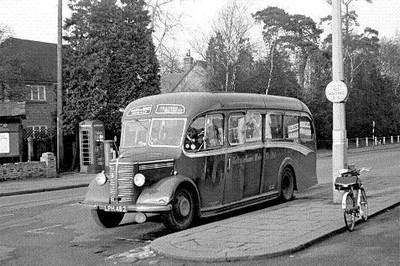
Walton-on-Thames Motor Co
Ltd operated the shuttle service between the town and the station
for many years after the war with a small fleet of Bedford OBs -
not a type instantly associated with London. LPH482 stands at
the station.
Photo © Richard Cripps
Walton-on-Thames station is some distance from the town, and had
not been served by London Transport. Rather, in one of the
few cases of LT permitting an independent operator in their central
area, a service dating from 1923 between the station and Walton was
allowed to continue. Operated by Walton-on-Thames Motor Co
Ltd until 1970, it was taken on by Golden Miller as their 604, but
discontinued at the end of 1974. A successor peak hours-only
service by Mole Valley Transport Services was discontinued within 6
months, but it was not for another nine months that, on 12 April
1976, LT stepped in by diverting the 218 in both directions to
double-run along Station Avenue and U-turn at the junction of
Ashley Park Road. Ian Hogben remembers the location: 'The
road layout was different from the present in that there were
no bollards in the main road and only a couple of bollards in the
'throat' of Ashley Park Road (instead of the current delta shaped
reservation). The 218 had to do a 180 degree turn around these
bollards and, with the poor turning circle of the RF you had
to start your turn from close to the nearside kerb (in the main
road), and many's the ruck we had with other motorists
because, even with our right indicator on and arm stuck right out
through the window, we were always being overtaken by other
vehicles part way through our manœuvre.'
Apart from weekday timetable reductions and the rerouting to
serve Walton Station, the 218 continued working whilst RFs were
withdrawn around it. The 201, 215
and 216 at Kingston, the 206 at Esher, the 264 at Walton and
the 224 at Laleham and Staines all
lost their RFs in 1976. At Shepperton and
Twickenham, Hounslow's RFs on the 237 and 202 lasted
until April 1977, whereupon the 218 and 219 were the lone RF
routes remaining in London. Because there were not enough BLs
for their replacement, it had been intended that the last RFs would
be replaced by a new sub-class of Swift, the SMD, and indeed the
blinds were printed accordingly.
The SMD class was a single-door seated version of the SMS
without the automatic fare equipment, and a few entered service at
Fulwell in 1975. But the Swifts themselves were failing fast,
and the programme did not continue. In any case, the larger
buses (the Swift was 33' long, 3' longer than an RF) would not fit
over the pits at Kingston garage. So 25 buses were spruced up and mostly
given new 3-year Certificates of Fitness, and Hounslow's 202 and
237 were not after all the last RF routes.
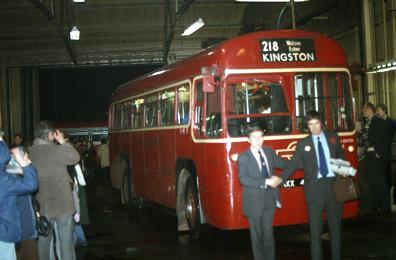
Eventually even they had to go, although not before the
last Ultimate ticket machines in use by LT were replaced by
Almexes, about a year before the end, in March 1978. This
allowed greater vehicle flexibility as Almexes were in use on the
BLs used on the 216 and Sunday 71, so these two classes
occasionally stood in for each other during that last year.
The garage problem was finally solved by reallocating the 218
and 219 to Norbiton, from where the routes could be operated with
new Leyland Nationals. 17 RFs
ran on the last day of operation, 30 March 1979, including the
specially selected last bus RF507
(photo © Paul Morris),
already with gold transfers, which had been prepared by
painting the window surrounds cream. Although the last RF
departure from Kingston was RF510 on the shorter 219, all attention
was on the 218, and the last journey had to be
duplicated by several RFs. When RF507 arrived at
Kingston early on Saturday morning of 31 March, the end of London
Transport operation of LT-designed single-deckers had
arrived. Enthusiasts enjoyed a special tour the following day
on RFs 510-512 over the routes of the 218 and 219 - the RFs' final
revenue-earning duty with LT.
Roger Towers, the driver of
RF507, receives a handshake before being allowed to pay in from the
last RF service journey operated by LT on 30 March 1979 (well,
early in the morning of 31 March, actually). We were pleased
to hear from Roger, who retired in 2014 and still has fond memories
of the RFs. He is very proud of having driven the last
journey and was overwhelmed by the number of people who turned out
that night to see the bus home.
Photo © John
Parkin
The progressive dismantling of the Kingston route network during
the Thatcher era affected the 218 with adjustments in the
route to serve Ham (Monday to Friday peaks in 1981/2) and the area
behind Sandown Park at Esher (Saturdays from 1985, by loop working
of Esher shorts). The route was extended to Thorpe Park for
the summers of 1985 and 1986. In October 1986, operation was
transferred to LCBS with SNBs operated from Staines Garage, the
route number being retained (with the unsocial hours tendered
service passing through several changes of operator)
until renumbering as 481 in July 1997. The old
number reappeared on the route in 2001, to be lost again in 2010
with another renumbering, to 458 operated by Abellio. In
2016, it works every 30 minutes (60 minutes Sunday) via the
traditional route, except that Walton Station is served from Queens
Road Hersham, as the U-turn at the station is no longer
possible.
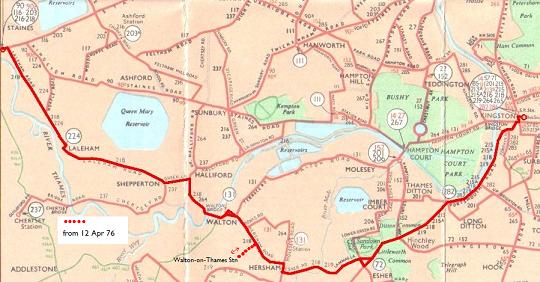
RF route in detail, with timing points
KINGSTON Bus Station, Clarence Street, Eden Street,
High Street Kingston, Portsmouth Road, Dittons Winters Bridge,
Portsmouth Road, Esher Marquis of
Granby, Portsmouth Road, High Street Esher,
Esher High Street,
Church Street (return via Esher Green), Lammas Lane, Esher Road,
Hersham Barley Mow,
Molesey Road, Hersham Road, High Street Walton, Walton Bridge Street, Bear,
Bridge Street, Walton Bridge, Walton Bridge Road, Gaston Bridge
Road, Green Lane Gaston
Bridge Road, Green Lane, Shepperton Station Approach,
Laleham Road, Shepperton Road, Laleham Church, Staines Road,
Laleham Road, Thames Street, Clarence Street, Bridge Street,
STAINES Moor Lane.
During the period of RF operation, new or revised one-way
systems were introduced in Staines, Walton, Esher and
Kingston.
From 12 Apr 76, the route double-ran along Station Avenue to
serve Walton Station.
The 1964 bus map (© London
Transport) shows the route as it ran from 1923 to 1997.
Buses stood at Staines West GWR station (closed).
Frequency
| Year |
Mon-Fri |
Sat |
Sun |
| 1936 |
60 mins |
30 mins |
30 mins |
| 1938 |
30 mins |
30 mins |
30 mins |
| 1941 |
30 mins |
15 mins |
15-30 mins |
| 1946 |
12-20 mins |
15 mins |
20-30 mins |
| 1951 |
10 mins * |
10 mins * |
15 mins * |
| 1953 |
10 mins * |
10 mins * |
15 mins * |
| 1959 |
10-15 mins * |
7-12 mins |
30 mins * |
| 1964 |
10-15 mins |
10-15 mins † |
60 mins * |
| 1969 |
10-15 mins |
7-10 mins |
60 mins * |
| 1971 |
10-15 mins |
7-10 mins |
60 mins ∆ |
| 1976 |
10-15 mins |
15 mins * |
60 mins ∆ |
* more frequent Kingston - Walton
† more frequent Kingston - Shepperton
∆ more frequent Kingston - Esher
The route took about 35 minutes from Kingston to Walton,
64 minutes for the full route. The July 1967 timetable is
here.
Faretable
The 1965 faretable is here.
RF allocation
Allocation joint with 219:
PVR 1960: Mon-Fri 22 +1 TD ex 215, Sat 21, Sun from 215
allocation
PVR 1961 (Aug): Mon-Fri 22, Sat 21, Sun from 215
allocation
PVR 1963 (Oct): Mon-Fri 22, Sat 22, Sun from 215
allocation
PVR 1966 (Jan): Mon-Fri 22, Sat 22, Sun 8
PVR 1968 (OMO): Mon-Fri 24, Sat 26, Sun 8
PVR 1971 (Jan): Mon-Fri 24, Sat 26, Sun 6
PVR 1972 (Aug): Mon-Fri 25, Sat 25, Sun 7
PVR 1973 (Mar): Mon-Fri 26, Sat 26, Sun 6
PVR 1975 (Feb): Mon-Fri 25, Sat 25, Sun 7
PVR 1976 (Apr): Mon-Fri 19, Sat 19, Sun 7
Buses operational on 30 March 1979: RFs 314, 369, 381, 428, 437,
441, 471, 481, 492, 495, 502, 504, 505, 507, 516, 520, 522 (as
listed by Ken Glazier, although this totals 17 against a PVR of
19).
Buses operating the commemorative tour on 31 Mar 79: RFs 510,
511, 512.
Of the 25 recertified buses, RFs 346
and 518 were withdrawn in 1978 and RFs 452 and 536 on 15 Mar
79. RF486 never returned to
passenger service after recertification.
Memories
Ian Hogben explains why Kingston RFs had what looked like bullet
holes on the rear panel here.
More of his memories of driving RFs at Kingston are on the 216 page, his recollections of high jinks on
early 218 journeys are on the Operations
in Practice page, more rivalry here and one of his passengers here.
Re-creation
RFs again operated the 218 at our Kingston
2009 RF event.
* Footnote on route number 62. Not only was this
applied to the routes that became the last RT and RF routes, but it
was also one of the first in the country area, effectively a
precursor of the Country Buses and the Green Line. When
General starting operations outside the London urban area with
three Sunday routes in July 1912, one was the 62, from
Hounslow to Windsor. A month later it became daily and was
renumbered 81. Which still operates today as far as
Slough.
|
|